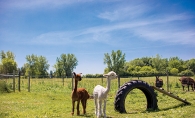When the Minnesota High School Cycling League (MHSCL) launched in 2012, one of the first people contacted as a potential coach was White Bear Lake Area High School teacher, Fred Feirn. The 50-year-old had been an active member of the local bicycle race scene for 30-plus years, first road cycling, then, beginning in the 1990s, mountain biking, and he was the ideal combination of motivated, talented cyclist and high school instructor to bring the sport to life for middle and high school kids. In his new role—he also coaches alpine skiing at WBLAHS—Feirn quickly went about writing a varsity lettering program for the sport which, when accepted in 2014, became one of the first in the nation for the growing club sport.
Mountain biking in Minnesota, whose terrain is generally a combination of winding grassy fields, gravel roads, and trails that twist around trees and up and down rolling hills, long has provided a competitive aerobic activity and an environment of camaraderie—but generally among adults. The launch of the MHSCL has quickly changed all of that.
More than 800 middle school and high school athletes—about 10 of whom hail from the White Bear Lake area—make up the MHSCL. The co-ed sport sends off racers in a group start by age level—first the junior high, then the freshman, sophomore, JV and varsity—five to six Sundays each fall. Races travel between 5- and 10-mile loops, generally, with the number of loops dependent, again, on age and experience. Scoring is similar to cross-country running, with the top four riders scoring for the team (of which only three can be of the same gender); points are assigned in descending order from the top finisher. The team with the most points wins the race, and riders accumulate points through the season’s cumulative races.

A Bit of Background
The Minnesota High School Cycling League is a branch of the National Intercollegiate Cycling Association (NICA), which began in 2009 in California with the mission of introducing mountain biking to younger kids as an accessible individual and team sport; the goal is to have a presence coast-to-coast by 2020, and the group currently has affiliates in 16 states. Remarkably, MHSCL is just four seasons old and is one of the fastest-growing subsets in the nation, with a total of 53 teams already formed and another eight or so in the works; similar to White Bear Lake, 10 others now offer varsity letters.
Joshua Kleve is the Minnesota league director and representative for NICA. “There’s Division 1 teams and Division 2 teams,” he says, noting D2 are smaller, composite teams from multiple schools. When it comes to equipment, the only requirement is that bikes—each athlete provides his or her own—have wide tires, ideally with front suspension, and helmets. “Costs vary by team and the number of races an athlete does,” Kleve says. “The typical cost (including team fees and all races) for a season is between $250 and $400.”
Erik’s in Vadnais Heights is the team shop partner for WBLAHS; there, students can get team jerseys and bike supplies, sometimes at special prices. “There is a scholarship program and a loan bike pool to help ensure that all student athletes interested in participating have the opportunity to, regardless of their financial situation,” Kleve says.
Mountain biking at most high schools is a club sport, but White Bear Lake’s program, with the chance to letter for any age that completes a set number of races in a season, has been a model nationwide. “I wanted that [letter] stature with it, academic codes,” Feirn says. “I wrote a lettering policy, and the athletic director accepted that. We don’t require the kids to do it; [last year] we rewrote that they can do a certain amount of races and still qualify. We’ve revised it so if you compete in and complete three of the five races, you letter, or if you can get on the podium [top five kids each race], you letter for the season automatically.”
At every race, each school represents themselves at their tents, and the parents, siblings and (often) dogs of all 745 athletes are present, Kleve says: “Once racers round the corner into the carousel at the finish line, the crowd lights up, and they lean over the barriers to cheer on the rider, cowbells and all.”
The New Aerobics
So what does this sport entail for students who perhaps have never participated in organized athletics before—and might be out of shape? Middle school races are quite accessible, usually just one lap of the course; varsity competitions, in comparison, often last an hour and a half or more. To prepare for this variety and rigor, practice starts August 1; some MHSCL schools practice all summer long and even year-round.
Junior Matt Weinberger appreciates the ability to challenge not only peers, but his own records and goals. Mountain biking with his family since he was 12, he really got interested in the sport when it was first offered at WBLAHS in his eighth-grade year. Then early in his sophomore season, he achieved a 2½-year-old goal of finishing in the top 10 of a race. He also lettered both his freshman and sophomore years. “Just the excitement of the sport is appealing,” he says, “flying through the woods and hitting jumps. There’s no other high school sport like that, to create that feeling.”
Indeed, not every student is a ball-and-stick athlete, says assistant coach Mark Weinberger (he’s also Matt’s dad); this sport offers an option outside of lacrosse, football and soccer, and has a very different feel than cross-country or swimming. “One of my favorite aspects is that cycling is a lifelong pursuit,” he says. “In the case of Matt, physically, he’s just in much better shape than he was. Once we hit the trails and we get into the tight, twisty stuff, he takes off and just goes. His bike handling is just so much better, and now he’s beating me.”
From a parent’s perspective, the biggest challenge is the logistics, Mark Weinberger says. “Kids can’t hop on an activity bus with their mountain bikes to go to the trails for practice,” he says, since the closest off-road single-track trails are in lower Maplewood at Battle Creek Park or in Woodbury at Carver Lake. “There has to be a parent willing to take their child to get them to the trail system.” (Coaches cannot give student athletes rides to the trailheads because of a district-wide policy against one-on-one interaction, for security reasons).
A Benefit for All
The perks of this sport are wide-ranging for students, parents, coaches and the community. “We’re focused on developing kids through mountain biking,” Kleve says. “[NICA] has core values of inclusiveness, and we want all kinds of kids from all different backgrounds and ability levels.”
To this end, all teams do some sort of community work: Feirn has talked about establishing cycling clinics locally, including safety demonstrations at the YMCA, and the team always has a presence in the homecoming parade. “It’s important to teach the students to give back,” Kleve says.
It’s notable that female riders make up only 25 percent of most MHSCL teams, a trend that groups like the NICA-affiliated Crank Sisters hopes to reverse by hosting women-only clinics and demo rides. The primary goals of MHSCL are inclusivity (there are no bench-warmers in mountain biking; every finish counts) and equality (there are no tryouts; everyone rides). This leads to a stronger body, mind and character; emphasis on giving back and sportsmanship lead to healthier well-rounded young people who find themselves academically rising toward the tops of their classes.
“The trickle-up effect is great,” Feirn says. “I had one of my students say his dad is on his [bike] trainer all the time now (in winter)—this is a dad who hadn’t ridden since college.”
The aerobic value coaches allude to is recognized by the parents and kids as well. In fact, when asked, 100 percent of participating students have stated that cycling in some form or fashion will be a lifelong pastime.
“I’ve tried to empower the kids. It is very individual, and we trust them to ride on their own—we instill that in them,” Feirn says. “This sport is really the kids against the course. It makes them more independent athletes for the future, too.”
And parents agree improved self-esteem is perhaps the biggest benefit to all involved. “Mentally, I think there might be a bit more confidence in Matt,” Mark Weinberger says. “Participating in the sport gives him a bit more swagger than he had.”
“I lettered last year, and hope to letter in it again,” Matt Weinberger affirms. “I’m trying to fill up the letter jacket.”
“The thing I like about cycling is it’s a life sport,” Mark Weinberger adds. “If you play football in high school, that’s all well and good, but it’s harder to do that in your 40s and 50s, [but] you can be cycling in your 70s and 80s. You can be racing if you want, you don’t have to be if you don’t want. You don’t have to be part of a team, you can succeed as an individual.”
Check out the website here for this year’s racing schedule.
The Minnesota State High School League (MSHSL)’s director, Joshua Kleve, shares some statistics about high school mountain biking around the state.
By the Numbers: Minnesota State High School League
•About 745 students participated in 2015.
•100% of participating students state they will ride bikes for the rest of their lives.
•85% of participants have an improved GPA of 3.0 or greater.
•Many teams voted to include trail stewardship as a team activity.
•96% of student athletes report health and fitness benefits.
•50% of parents resume/start riding as a result of their child’s participation.









